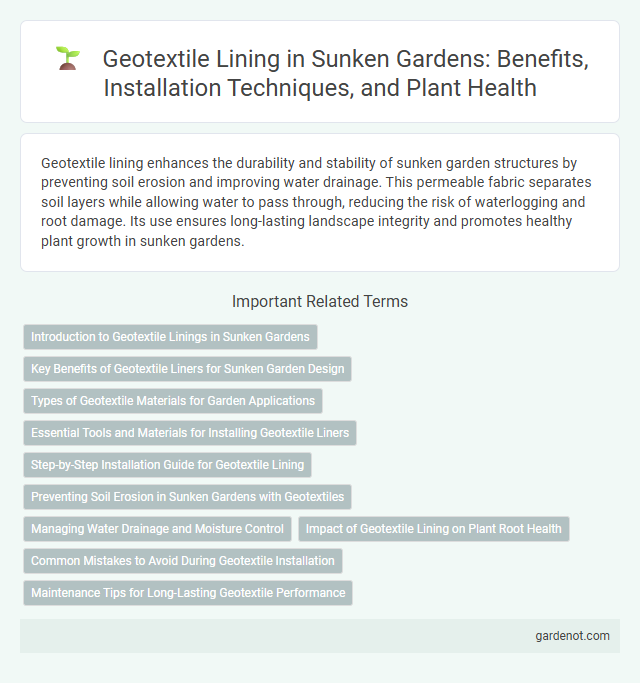Geotextile lining enhances the durability and stability of sunken garden structures by preventing soil erosion and improving water drainage. This permeable fabric separates soil layers while allowing water to pass through, reducing the risk of waterlogging and root damage. Its use ensures long-lasting landscape integrity and promotes healthy plant growth in sunken gardens.
Introduction to Geotextile Linings in Sunken Gardens
Geotextile linings in sunken gardens provide essential soil stabilization and drainage control, preventing erosion and water seepage within the garden bed. These permeable fabrics allow water to filter through while maintaining soil integrity, promoting healthy plant growth and structural longevity. Integrating geotextile liners enhances the garden's sustainability by improving moisture retention and minimizing root intrusion into drainage layers.
Key Benefits of Geotextile Liners for Sunken Garden Design
Geotextile liners enhance sunken garden design by providing superior soil stabilization and erosion control, preventing substrate displacement and maintaining structural integrity. They improve drainage efficiency, reducing waterlogging risks and promoting healthy plant root development. These liners also act as a barrier against weed growth, minimizing maintenance and ensuring a cleaner, more aesthetically pleasing garden environment.
Types of Geotextile Materials for Garden Applications
Geotextile lining in sunken gardens commonly utilizes woven, non-woven, and knitted geotextile materials, each offering distinct benefits for soil stabilization and drainage control. Woven geotextiles provide high tensile strength suitable for erosion prevention, while non-woven varieties excel in filtration and water permeability. Knitted geotextiles offer flexibility and puncture resistance, making them ideal for irregular garden beds and complex landscaping designs.
Essential Tools and Materials for Installing Geotextile Liners
Essential tools for installing geotextile liners in sunken gardens include shovels, rakes, and utility knives, which ensure precise cutting and ground preparation. High-quality geotextile fabric specifically designed for soil stabilization and water filtration is critical, alongside staples or landscape pins to secure the material firmly in place. Proper installation also requires gloves for safety, measuring tapes for accurate fitting, and stakes or sandbags to prevent fabric displacement during placement.
Step-by-Step Installation Guide for Geotextile Lining
Start by preparing the sunken garden surface, ensuring it is clean and free of debris for optimal geotextile adhesion. Unroll the geotextile fabric carefully, overlapping edges by 6-12 inches to prevent soil erosion and enhance stability. Secure the fabric with landscape staples or pins at regular intervals, then proceed to cover with soil or mulch to protect the lining and support plant growth.
Preventing Soil Erosion in Sunken Gardens with Geotextiles
Geotextile lining in sunken gardens serves as an effective barrier to prevent soil erosion by stabilizing the soil structure and enhancing water drainage. The permeable fabric allows water to pass through while retaining soil particles, reducing runoff and soil displacement. This erosion control method promotes healthy plant growth and maintains the garden's structural integrity over time.
Managing Water Drainage and Moisture Control
Geotextile lining in sunken gardens serves as an essential barrier that enhances water drainage while effectively controlling soil moisture levels. This textile layer prevents soil erosion and maintains optimal moisture balance by allowing excess water to pass through without displacing soil particles. Proper installation of geotextile lining promotes healthy plant growth by reducing waterlogging and improving overall soil stability.
Impact of Geotextile Lining on Plant Root Health
Geotextile lining in sunken gardens enhances soil stability while promoting optimal aeration and moisture retention, critical for robust plant root health. This permeable fabric prevents soil erosion and compaction, allowing roots to access essential nutrients and water efficiently. Improved root respiration and reduced risk of root rot contribute to healthier, more resilient plant growth in these landscaped environments.
Common Mistakes to Avoid During Geotextile Installation
Common mistakes during geotextile lining installation in sunken gardens include improper surface preparation, which can lead to punctures and reduced fabric lifespan. Overlapping seams incorrectly or insufficient seam overlap compromises water filtration and soil separation, causing erosion and plant root intrusion. Neglecting to secure the geotextile edges properly results in fabric displacement and undermines the structural integrity of the lining.
Maintenance Tips for Long-Lasting Geotextile Performance
Regular inspection of geotextile lining in sunken gardens is crucial for identifying any tears or displacement early, preventing soil erosion and water seepage. Keeping the area free from sharp debris and avoiding heavy machinery over the lining helps maintain its structural integrity and extends its lifespan. Applying a protective layer of soil or mulch can shield the geotextile from UV damage and physical wear, ensuring long-lasting performance.
Geotextile lining Infographic

 gardenot.com
gardenot.com